Susan Marshall & Company turn music videos inside out in Play/Pause
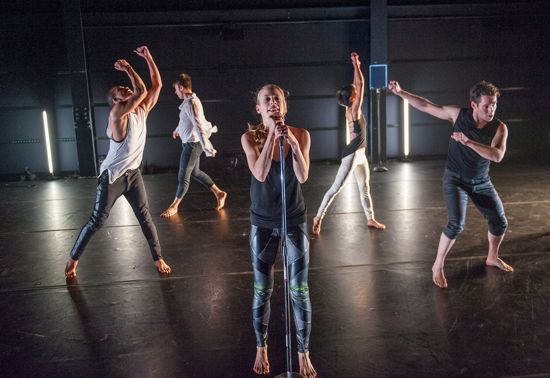
Susan Marshall’s Play/Pause. (L to R): Christopher Adams, Luke Miller, Kristin Clotfelter, Ching-I Chang, and Darrin M. Wright. Photo: Stephanie Berger
Did it begin with the advent of the remote? Mute the commercial from the comfort of your easy chair. Push the buttons; surely there’s something on another channel that’s better than the something you’re watching. Fast forward through a video. Oops, did the cat knock something over? Press pause. Bored during intermission in the theater? Turn your smart phone back on. Don’t let art interrupt your social networking for too long. Does this amount of control make you feel like a god? Or a little bit lost?
Years ago MTV introduced us to a fast-twitch mode. The camera would cut from a singer’s face to a band that was playing, for some reason, on the rim of the Grand Canyon. A dog might appear. The singer would get a new outfit and an anonymous lover would come into the frame and stroke her mic. Someone else was hitting the buttons—someone with a sense of unreasoning fantasy and an aptitude for glossiness, glamor, and aggressively sexual confrontation.
These thoughts have been fermenting ever since I saw Susan Marshall’s Play/Pause at BAM Fisher, as part of the 2013 Next Wave Festival. I wonder if Marshall’s position (since 2009) as director of dance at Princeton University’s Lewis Center for the Arts and her daily contact with students has figured in her current interest in pop music, tv dance competitions, and music videos. But because she is a choreographer who has always been interested in human behavior and in refining and dislocating everyday gesture, Play/Pause decontextualizes and deconstructs popular dance entertainment and situates it and its appurtenances in an eerie, restrained, cooled down atmosphere that is disturbing and, at times, strangely moving.
If you want to see music video on a diet, watch Marshall’s stylish Stop (vimeo.com/72452949). This excerpt from Play/Pause, which functions as a promo for the stage presentation, was shot in black-and-white by William Cusick. In the video, dancers Ching-I Chang and Kristin Clotfelter wear heels, thigh-length stockings, and high-necked sleeveless leotards (usually black, but white in some shots) similar to those worn by Beyoncé’s two back-up women in “Single Ladies.” But Chang and Clotfelter are austere in their glamor. To the pounding of David Lang’s rock score, they may open and close a leg, put one hand behind their heads, toss their hair around, silently snap their fingers, and stare stonily at the viewer. The camera may close in on their buttocks creeping out below the leotards. They do not, however, swing their hips raunchily and flirt. Although their speed and range in space increase somewhat, these women never lose their staccato, pose-pose precision or their nonchalance.
Play/Pause as a whole is richer than this in fantasy images, shorthand drama, and enigmas—all of these significantly aided by Eric Southern’s lighting and Andreea Mincic’s set design. Microphones are featured; so are fluorescent tubes, which, at one point are held at a slant by Darrin M. Wright, Luke Miller, and Peter Simpson, as if the men were rock singers manhandling mic stands. Actual stands hold panes of glass (maybe sixteen inches by two feet) framed by thin tubes of blue light. The face of a person standing behind one of these acquires a strange luminosity.
Strange too is the contrast between wacky hi-tech imagery and matter-of-fact behavior on the part of the six performers (all collaborating choreographers). Also, to begin with, they wear clothes that look like the idiosyncratic gear they might wear to a rehearsal; these, by Diana Broussard, are eventually peeled away to reveal sleeker, more form-fitting attire. The musicians who play Lang’s score (Michael McCurdy of Mantra Percussion and Taylor Levine and James Moore of the electric guitar quartet Dither,) sit on the balcony overlooking stage left. In addition to emitting powerful, thrashing rhythms and occasional sweeter bits of melody, they provide punctuating bursts of sound and often stop suddenly, as if someone had indeed pressed “pause.”
The beginning of Play/Pause offers a schematic view of rhythm. A large, slightly slanted, free-standing plywood “wall” stands at one side of the stage near the audience. Miller tears strips from what looks like a roll of wide black electric tape and sticks them to the board in carefully placed vertical or horizontal alignments. When Chang rubs her mic across the board from left to right, she “reads” it into rhythms—the harsh roar of the wood punctuated by smoother blips. While Christopher Adams (wearing socks with glitter on them) starts to dance, Simpson removes the strips of tape one by one and pushes the “wall” upstage. Wright and Clotfelter arrive. The music kicks in.
On and off throughout the piece, the dancers move big, as if they were hurling the dancing away, or slashing, hammering, and slicing the surrounding air. At times, one or the other of them ramps it up into a physical frenzy. The image of one person sliding down another’s stuck-out leg or getting a foot caught on someone else establishes itself as an occasional motif. Whether this show is the show or preparation for it is moot. Simpson, a terrific actor-dancer, asks mildly, “What am I doing here?” but doesn’t wait for an answer. It turns out that he also occasionally plays host and acts as stage manager. “1-2-3-4!” People count off to start a tight routine. At a later point, they trade off calling out “AND!” as if to initiate a dance, but they’re already rushing around in one. Marshall turns the step-touch, marking-time step of jazz dance into something classier by having the dancers take turns freezing and starting up again. Simpson plays with the turn-out-turn-in of one leg while lying on the floor.
As the piece develops, certain images acquire more significance. Miller has taped another pattern to the board, and Chang comes to pass her mic across it. He blocks the mic with his hand before it reaches the end. She starts over; he stops her sooner. After a few passes, she’s doggedly rasping the mic over only the first strips of tape, where it creates a juddering, aborted rhythm.
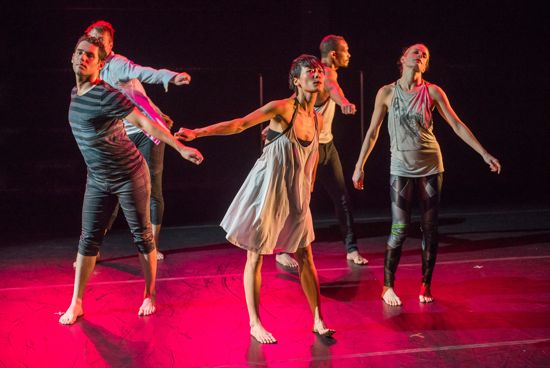
(L to R): Darrin M. Wright, Luke Miller, Ching-I Chang, Christopher Adams, and Kristin Clotfelter. Photo: Stephanie Berger
The lighting, too, is often aborted. Sometimes Simpson or one of the others trundles a light into position or uncoils an electrical cord. Once, the board is turned to reveal a battery of lamps attached to it; for a few moments, the stage is white hot; then the lights go out.
Breath is the rhythm that animates living creatures. Our lifetime performance. Miller reminds us of this by inhaling and exhaling into a mic. Simpson comes very close to the front row with his mic and begins breathing. After a few seconds, he holds the mic out to us, and the spectators in the first rows exhale quietly together. It’s an ironic take on the loud, dance-competition host urging the audience to applaud its favorites. The glass panes subvert their family resemblance to tv monitors by making flesh-and-blood performers’ breath visible. Simpson stands behind one, and his exhalations cause flowers of mist to bloom and diminish on the glowing surface in a silent rhythm. Clotfeld lays him and his frame out sideways and lies beside him, staring at him.
In another curious encounter, Miller stands behind a pane, and Chang, on the other side of it, places a horizontal black tape at the level of his eyes and another in front of of his mouth; then she outlines and stubbs out his blinded, silenced face with her raucous mic. He reaches around to stroke her hair and pull her against the glass. After drying his face, he rolls away, and she hits her own head against the now blank pane. The mood is sweeter, maybe, when Miller cuddles up behind Clotfeld so that both their heads appear behind the glass; tenderly, he manipulates her arms into gestures—perhaps training her for something he hopes she’ll perform.
What is a show without a finale? The six mesmerizing performers in Play/Pause line up in front of us and pant. Then they back away, each at his/her own discretion, and stalk individually back into the line, pausing in new, chillier light. It’s disturbing and inexplicably poignant when they finally stand in a line, each behind a plate of glass, all of them making little everyday artworks with their breath, while gesturing jerkily to music that turns slow and soft and then lurches to a halt. They step out from behind the frames, and Simpson says quietly and tiredly to us, “thank you.”
I feel wrenched about by what I’ve seen and heard. Marshall seems to have abstracted elements of shows and videos that she has watched, then freeze-dried these, shaken them out, turned them upside down, and stirred them together judiciously to see what happens. I’m not sure of the outcome, but I can’t get Play/Pause out of my head. It’s going into re-runs at this moment.

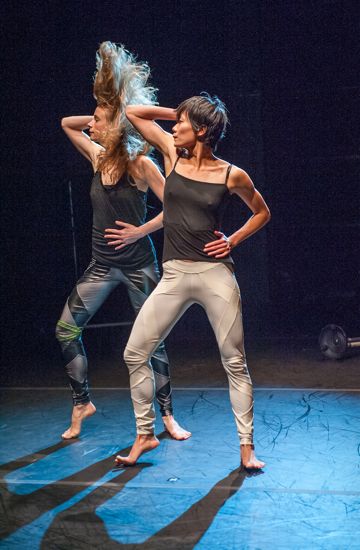
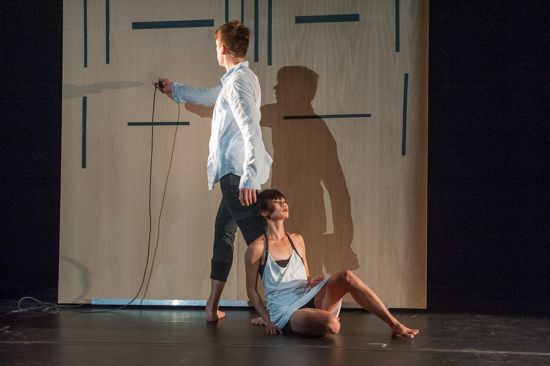
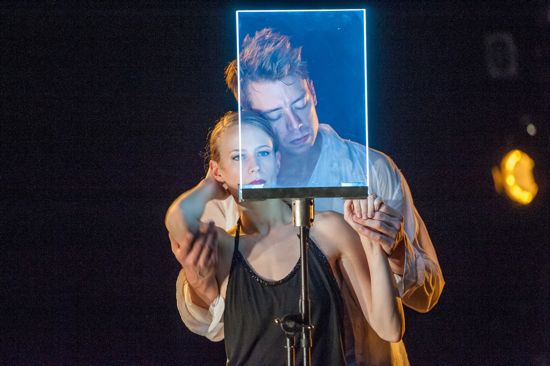
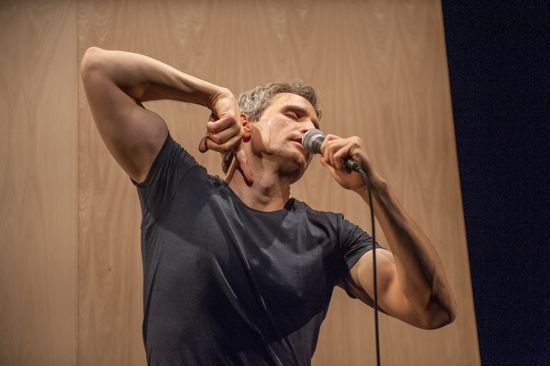
As usual, your eye and your pen are outstanding. You always make me think about what I saw or inform me about events I wasn’t able to attend. “I feel wrenched about by what I’ve seen and heard. Marshall seems to have abstracted elements of shows and videos that she has watched, then freeze-dried these, shaken them out, turned them upside down, and stirred them together judiciously to see what happens. I’m not sure of the outcome, but I can’t get Play/Pause out of my head. It’s going into re-runs at this moment”: an outstanding formulation of my own experience with Marshall’s fine and powerful piece. Both you and she are at the top or your games. Thanks to both of you for your great work.
I met Luke Miller in one of his other jobs–as a bartender–a few years ago and since then have tried to see Susan Marshall dances when I could. I saw one at an outdoor tribute to Cunningham, another on a Juilliard program (at which I saw you, and Tharp’s Deuce Coupe). Part of what has stood out, and appealed to me, was her interest in “human behavior and…everyday gesture,” as you put it. Carelessness with the calendar led me to miss the BAM Fisher run. I’m kicking myself again now that I’ve gotten around to reading your review. Descriptive and thoughtful as always, it’s _like_ being there, but not the same.
By the way, these dancers are a good-looking bunch. It’s easy to notice that in stills and to wonder what difference it makes. Usually, in a live performance I barely notice, but mere looks register there too. In aesthetics, beauty and handsomeness are no longer ideals; they’re no longer expected, that is, and may even be suspect. We do still see them, though. When I encounter them, I suppose I should just take them as an extra reward. (Pardon me for bringing up a complex subject, maybe in an unclear way; I couldn’t help thinking about it as I looked at the photos.)